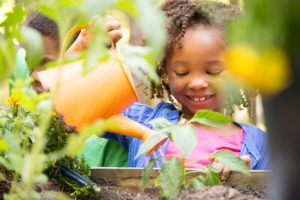Next to building a patio, one of the most popular backyard projects for many homeowners is growing their own vegetable garden. As more people are making conscious decisions to eat healthier, it's come as no surprise that at-home vegetable gardens are growing in popularity. A fully-functioning garden that houses a variety of different fruits and vegetables is a great way to encourage your family to eat more greens, while cutting down on your costs at the grocery store.
A vegetable garden can also help your family eat less pesticides and other chemicals, since you have complete control over the way you choose to grow and harvest your produce. Not to mention, it's also a fun activity for the whole family to spend quality time together outdoors. Here's how to enjoy the fruits of your labor:
Space
The biggest misconception homeowners have about starting a garden is that they don't have the space. The truth is, a vegetable garden doesn't require a lot of it. If you don’t have a large backyard, that's okay! Many vegetables can be grown in containers or in raised beds. You can also choose to create a mini garden right on your deck or balcony. Regardless of the area you dedicate to be your vegetable garden, keep in mind that the area must receive at least six hours of direct sunlight. The best spot is the south side of your house in an area with little to no shade.
Another key factor is your soil. If you choose to use your land for gardening, you may want to get a soil test done. Soil sample kits are available in many home improvement centers. The results will tell you what type of fertilizer you need to add to your soil for optimal vegetable growing conditions. Also, be sure to add organic compost to your soil when you turn it over in the spring to give it nutrients that will ensure strong plants and tasty produce.
Choose Wisely
You don't need to have a great green thumb to succeed; what you need instead is a master plan, a sunny space for your plants, moist soil and plants that do well in your soil type. You can choose to grow from seeds or from seedlings. Keep in mind that seeds are more cost-effective, but can take a little while to germinate, so be sure to start them at the time indicated on the packets. Seedlings, on the other hand, can dry out quickly, so be sure to plant immediately, or water daily until you're ready to plant. Most seedlings can be purchased at your local garden center.
The most popular vegetable garden staple are tomatoes. They naturally grow throughout the season, so you won't have to replant. There's a reason why basil and tomatoes taste so great together. By planting basil near your tomato patch, it will act as a natural bug repellent and provide a unique flavor profile to your tomatoes.
Leafy salad greens like lettuce, kale, spinach and endive are a beginner's best friend. They grow quickly, and are an easy harvest: just cut off the top, wash and enjoy. Cucumbers and zucchini don't take up too much space when they are grown vertically. Also, root vegetables like carrots and potatoes grow easily from seeds. Well-drained soil is critical for their growth.
Pest Control
One of the biggest ongoing problems for most gardeners is keeping pests, insects and fungal diseases at bay. If your garden is in an area that is prone to deer, build a fence that is at least eight feet high. When building it, think below the ground, as well. You may want to install the fence up to two inches under the soil to keep smaller critters like rabbits and groundhogs from digging under.
Garden fabric—or row covers—will protect your vegetables from insects. They are easy to find and will help retain moisture in your soil. For larger insects like caterpillars, simply remove them by hand. If you do choose to use a pest-control chemical spray, be sure to read the label carefully and follow all instructions, including safety measures like wearing gloves and/or a face mask.
When doing your daily watering, be sure to water the soil and not the plant itself to prevent fungal growth. The plant leaves should be completely dry by the time the sun sets. If you notice a leaf that has a fungus or mildew, simply remove it and throw it out immediately to prevent it from spreading to your entire garden.
Not only can growing a vegetable garden become a great hobby for the entire family, it's also a great way to live a more nutritious lifestyle. It's a great feeling of accomplishment to be able to grow food from scratch!
 Kris Holland is the director of Black River Landscape Management. To learn more about outdoor living trends and design your own vegetable garden, please visit www.blackriverlandscaping.com.
Kris Holland is the director of Black River Landscape Management. To learn more about outdoor living trends and design your own vegetable garden, please visit www.blackriverlandscaping.com.









Great tips. I follow my of these in my landscaping business in Atlanta. Keep up the awesome content.